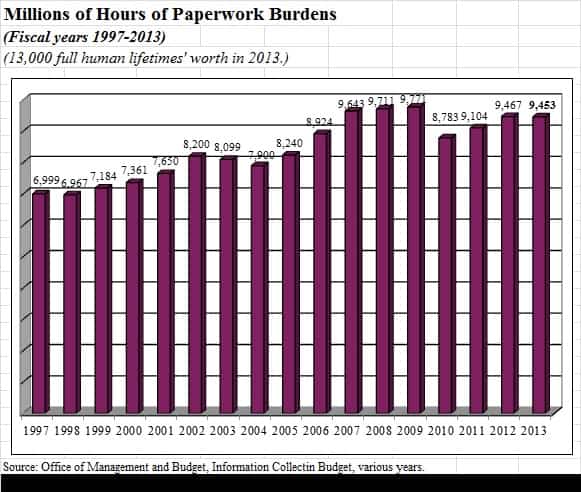How Federal Paperwork and Red Tape Has Grown since President Clinton

In recent five-part series called The 2014 Federal Paperwork and Red Tape Roundup, I took a look at hours of paperwork for various departments and agencies in fiscal year 2013.
What I didn't do was look at how hours have changed over the past decade-plus of data collected under the Paperwork Reduction Act. The Office of Management and Budget assembles such information.
The chart nearby depicts millions of hours of annual paperwork since 1997. In President Bill Clinton’s last year, 2000, there were an estimated 7.361 billion hours of paperwork burden (of course, fiscal year 2001 had been underway a few months by the time Clinton left office).
Since that time, paperwork burdens have grown 28 percent to 9.453 billion in the current 2014 Information Collection Budget (which depicts fiscal year 2013).

During the intervening years, adjustments to data collection happened frequently, often in favor of reducing paperwork. Notably, for example, the drop in 2010 was explained by the Office of Management and Budget in the 2011 Information Collection Budget (p. iv) as follows:
Adjustments were the principal factor driving the decrease in aggregate burden. The most notable adjustment is the Department of Treasury’s re-estimate of the paperwork burden placed on the public by its 1040 series of tax return documents and supporting forms.
Since 2010, hours have ticked back upward, then dipped a little in 2013.
I'd noted that the 9.45 billion hours required in 2013 would amount to the equivalent of over 13,000 80-year human lifespans. There is a great deal of paperwork with which Americans must contend; the notion that rates of increase of up to 28 percent in a span of less than two decades is acceptable, compounded into the future, requires reflection.
We are starting to learn how burden hours may amount to significantly more than what has been traditionally presented. In Appendix C (p. 63) in the new Information Collection Budget, called “Additional Agency Burdens,” we are reminded that the traditional “Data Call” outgoing to agencies and reflected in the annual Information Collection Budget has covered some 22 executive departments and agencies, and six independent agencies.
OMB finds it fitting to note in the new edition that there are significant other burdens, and that it “has added this appendix to show all agencies with paperwork burdens greater than one million hours in FY2013.” There are eight agencies that fit that bill, and they add 94.55 million hours to the 9,453 million hour tally we already have, as seen here.
- Consumer Financial Protection Bureau: 39.31 million hours
- Federal Reserve System: 13.48
- Equal Employment Opportunity Commission: 13.25
- Consumer Product Safety Commission: 7.47
- Commodity Futures Trading Commission: 7.42
- Office of Personnel Management: 6.43
- General Services Administration: 6.17
- Corporation for National and Community Service: 1.02
This “more than a million hours” category is an area to watch. Note that the largest “offender” among them is the new new Consumer Financial Protection Bureau, created by the “Dodd-Frank Wall Street Reform and Consumer Protection Act of 2010.” CFPB accounts for 39.31 million hours.
Alas, Part 1 of the 2014 Federal Paperwork and Red Tape Roundup, referred to the handsome salaries those working in financial sector compliance are beginning to enjoy. Good for them, perhaps not so great for everyone else.